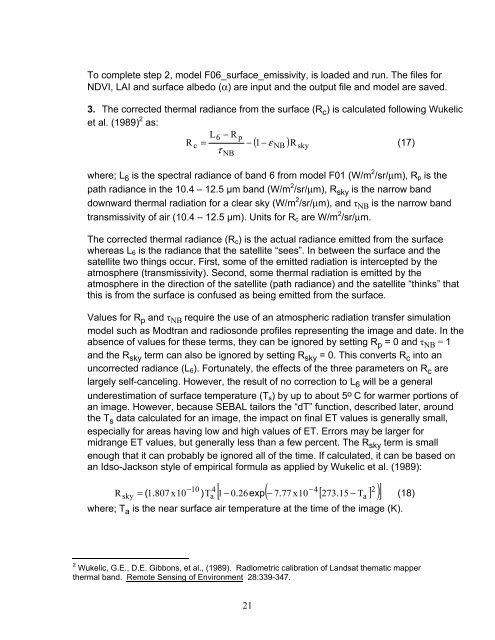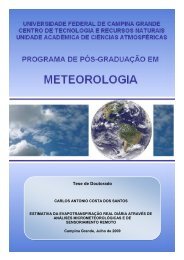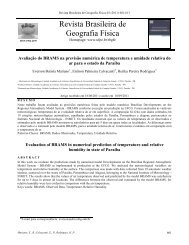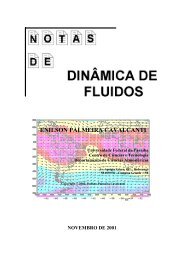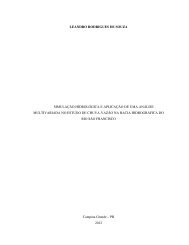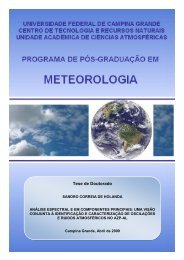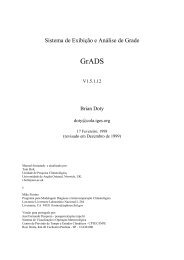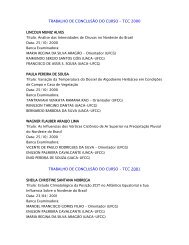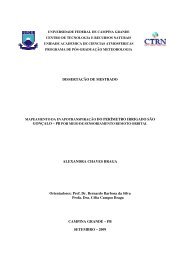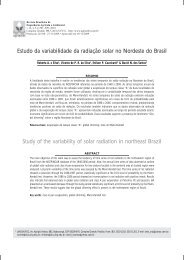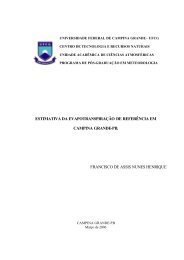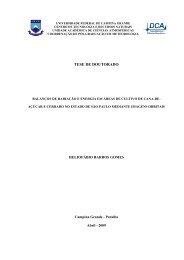You also want an ePaper? Increase the reach of your titles
YUMPU automatically turns print PDFs into web optimized ePapers that Google loves.
To complete step 2, model F06_surface_emissivity, is loaded and run. The files forNDVI, LAI and surface albedo (α) are input and the output file and model are saved.3. The corrected thermal radiance from the surface (R c ) is calculated following Wukelicet al. (1989) 2 as:L6− R pR c = − ( 1−ε NB ) R sky(17)τ NBwhere; L 6 is the spectral radiance of band 6 from model F01 (W/m 2 /sr/µm), R p is thepath radiance in the 10.4 – 12.5 µm band (W/m 2 /sr/µm), R sky is the narrow banddownward thermal radiation for a clear sky (W/m 2 /sr/µm), and τ NB is the narrow bandtransmissivity of air (10.4 – 12.5 µm). Units for R c are W/m 2 /sr/µm.The corrected thermal radiance (R c ) is the actual radiance emitted from the surfacewhereas L 6 is the radiance that the satellite “sees”. In between the surface and thesatellite two things occur. First, some of the emitted radiation is intercepted by theatmosphere (transmissivity). Second, some thermal radiation is emitted by theatmosphere in the direction of the satellite (path radiance) and the satellite “thinks” thatthis is from the surface is confused as being emitted from the surface.Values for R p and τ NB require the use of an atmospheric radiation transfer simulationmodel such as Modtran and radiosonde profiles representing the image and date. In theabsence of values for these terms, they can be ignored by setting R p = 0 and τ NB = 1and the R sky term can also be ignored by setting R sky = 0. This converts R c into anuncorrected radiance (L 6 ). Fortunately, the effects of the three parameters on R c arelargely self-canceling. However, the result of no correction to L 6 will be a generalunderestimation of surface temperature (T s ) by up to about 5 o C for warmer portions ofan image. However, because <strong>SEBAL</strong> tailors the “dT” function, described later, aroundthe T s data calculated for an image, the impact on final ET values is generally small,especially for areas having low and high values of ET. Errors may be larger formidrange ET values, but generally less than a few percent. The R sky term is smallenough that it can probably be ignored all of the time. If calculated, it can be based onan Idso-Jackson style of empirical formula as applied by Wukelic et al. (1989):−4[ 1−0.26exp( − 7.77 x10 [ 273.15 − Ta] )]2−104R sky = ( 1.807 x10 ) Ta(18)where; T a is the near surface air temperature at the time of the image (K).2 Wukelic, G.E., D.E. Gibbons, et al., (1989). Radiometric cali<strong>br</strong>ation of Landsat thematic mapperthermal band. Remote Sensing of Environment 28:339-347.21


